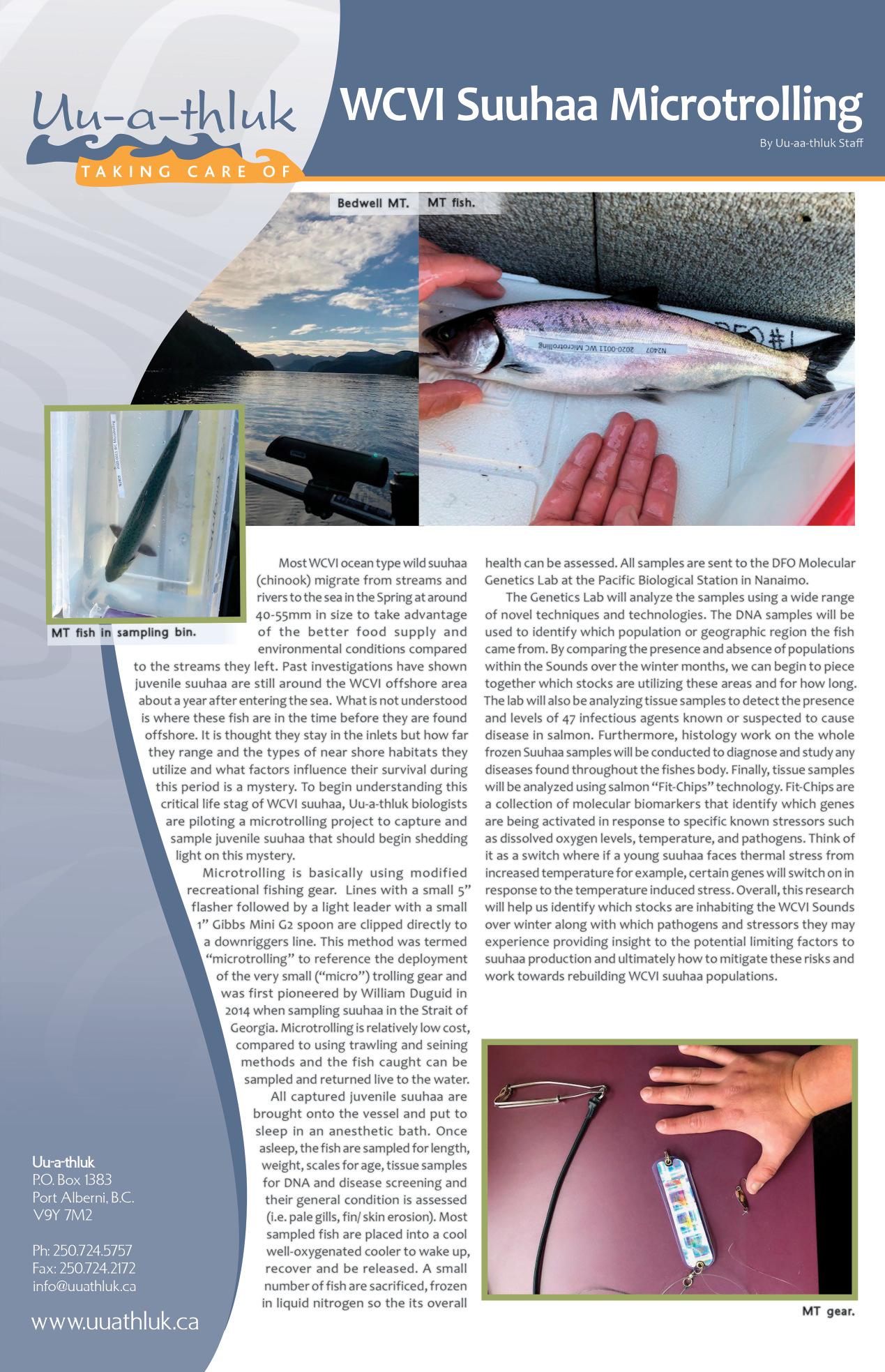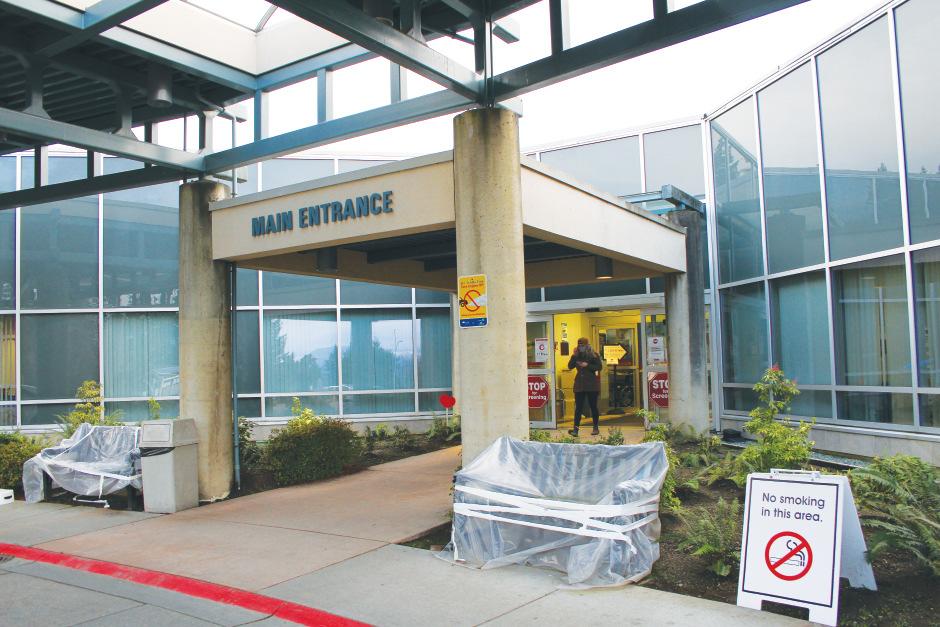
7 minute read
Recently published canoe book
Cathedral Grove remains closed, province says high visitation to the a raction makes social distancing diffi cult
By Melissa Renwick Local Journalism Initiative Reporter
Advertisement
Vancouver Island, BC - The provincial government has pledged $5-million towards development projects spanning across 24 B.C. parks. As part of the province’s StrongerBC economic recovery initiative to promote wellness and employment, the funds will be allocated towards improvements, such as the instillation of a raised boardwalk and viewing platform in MacMillan Provincial Park and the replacement of boardwalk and stair structures in Maquinna Marine Provincial Park. “We have heard the call for greater access to the outdoors to promote health and well-being during COVID-19,” said George Heyman, minister of Environment and Climate Change Strategy in a news release. “These meaningful projects create jobs to address those needs as part of our support for B.C. communities.” The Maaqutusiis Hahoulthee Stewardship Society (MHSS) and 43K Wilderness Solutions were awarded a contract for the replacement of a two-kilometer boardwalk at Hot Springs Cove, which is located at Maquinna park. “This work is the result of a Park Operator Agreement between BC Parks and the Ahousaht First Nation formed in 2017 for the maintenance of Maquinna Marine Park,” said the Ministry of Environment and Climate Change Strategy. “The Agreement establishes a shared commitment for BC Parks and the Ahousaht First Nation to explore and pursue economic development opportunities.” Two crews of three carpenters from Ahousaht, along with a shift supervisor from 43K Wilderness Solutions, will rotate in to replace the boardwalk. The $1.1-million project kicked-off last week and is anticipated to be complete by the end of the May, said MHSS general manager John Caton. A “rustic” camp at Hot Springs Cove has been erected, where each worker is equipped with their own 10-feet by 12-
Photo by Melissa Renwick The sun rises over Hot Springs Cove, on Sept. 23, 2017, the location of a provincial park undergoing upgrades for visitors. feet sidewall tent that is outfi tted with a compact and do not allow for physical lumbians can enjoy the beautiful natural propane heater and bed. The camp has distancing in this area.” landscape of our province.” an enclosed kitchen and on-demand hot The announcement is part of the prov- Around two per cent of the province’s running water. ince’s $10-billion COVID-19 response, parks and protected area systems have While Caton said he has his fi ngers which is designed to protect people’s been largely developed with a visitor-use crossed that COVID-19 is going to allow health and livelihoods, while supporting focus, including facilities such as campthe hot springs to open this year, only businesses and communities. grounds, boat launches and parking lots. time will tell. As one of the largest park systems in “We are celebrating this investment in Cathedral Grove, located in MacMil- North America, B.C. has over 1,000 BC Parks, which will have far-reaching lan Provincial Park, remains closed as it provincial parks, recreation areas and benefi ts for people and nature,” said Annormally experiences over 500,000 visits ecological reserves that cover around nita Mcphee, executive director of the per year, according to the Ministry of En- 14.4 per cent of the provincial land base. Canadian Parks and Wilderness Society, vironment and Climate Change Strategy. “An investment in our parks is an in- B.C. chapter. “Keeping parks accessible “Due to the unique nature of the park, vestment in the people of British Colum- and sustainably supported will create a the trail system and boardwalks are bia,” said Kelly Greene, Parliamentary more welcoming parks system, building very narrow making appropriate physi- Secretary for Environment in a release. healthy communities and future nature cal distancing extremely challenging,” “Getting outside is more important than stewards.” said the ministry. “The parking areas at ever, and our government is committed MacMillan Provincial Park are small and to expanding parks so that all British Co-

Recently released work has images and descriptions of various styles of canoes found up and down the coast
By Denise Titian Ha-Shilth-Sa Reporter
Vancouver Island, BC – A new book showcasing the historical views and development of canoes as well as contemporary stories featuring canoes has been published. Alan L. Hoover, a retired curator and manager at the Royal British Columbia Museum co-authored Northwest Coast Canoes of Indigenous North America, which was released in December 2020. Hoover collaborated on the book with retired researcher and author Eugene Arima, who wrote A Report on A West Coast Whaling Canoe Reconstructed at Port Renfrew, B.C. (1975) and The Whaling People of Vancouver Island and Cape Flattery (2011) Hoover says he began working at RBC Museum in 1968 and has always been interested in northwest coast history, culture and artifacts. He gained interest in canoes through is work with Eugene Arima. “He worked with Chief Charlie Jones, Queesto, in Port Renfrew,” said Hoover. Back in the early 1970s, Arima lived among the Pacheedaht for a few months while building a traditional whaling canoe under the tutelage of Queesto, who was Pacheedaht’s Tyee Ha’wilth (head chief) and, at that time, was over the age of 100. Following the canoe project, Arima published a report. The canoe they made is now on display at Kwisitis Visitor Center (formerly Wickaninnish Visitor Centre) near Ucluelet. In 1983 Arima wrote The West Coast People: The Nootka of Vancouver Island and Cape Flattery. More than two decades later Arima approached Hoover with the idea to write a revision of his 1983 book. “We worked together putting out a second edition. He wanted to update it, so that’s how I got involved,” said Hoover. The revised book was re-named The Whaling People of the West Coast of Vancouver Island and Cape Flattery, released in 2011 and published by the RBC Museum. Arima has extensive knowledge about west coast style canoes. Besides his work on the Pacheedaht vessel, Arima was involved in a project in Northern British Columbia. “Eugene worked with Calvin Hunt up in Fort Rupert,” Hoover shared. The men were recreating an old-style canoe that had sort of disappeared, according to Hoover. The style of canoe they were building was in use around time of European contact but went out of fashion. It was this canoe story that sparked the interest in writing a book about canoes. “We decided to add history of other canoes,” said Hoover. The authors connected with master carver Joe Martin of Tla-o-qui-aht, who is included in the book with information and photos about steaming canoes to help shape them. The book is fi lled with photographs and illustrations of the various styles of canoes found up and down the west coast. Along with historical photos, there are many from more contemporary times. There are images of canoe makers as well as events like Tribal Journeys, which has caused a resurgence in canoe culture. Hoover says he wants to share these stories with people not only because he is a “history nerd”, but also because it is an important part of northwest coast Indigenous culture. “Back when they were building the railway (from Victoria to northern Vancouver Island) guys were hired to paddle canoes around beneath the trestles to pick up any guys that may have fallen off the trestle,” said Hoover. Today, traditional style canoes are used in the tourism industry. “The tradition goes way back,” said Hoover. He noted that for coastal people, the

Ha-Shilth-Sa archive photos Northwest Coast Canoes of Indigenous North America draws upon images and stories of Nuu-chah-nulth canoes. Pictured are Ha-Shilth-Sa archive photographs of Mowachaht/Muchalaht members following the orca Luna in 1999 (above) and participation in previous Tribal Journeys events (below). canoe was to First Nations what cars are North America – A Historical View of to people today. The waterways were the Styles and Development was published highways. by Northwest Coast Canoe Publications “Some people thought canoe making (www.northwestcoastcanoepublications. disappeared, but it hasn’t, it has evolved,” com ) said Hoover, adding that the tradition was Hoover is currently working with Joe kept alive by people like Chief Charlie Martin on a new book on canoe making. Jones, and now Joe Martin as well as Work on this book has been stalled due to others. the COVID-19 pandemic. Northwest Coast Canoes of Indigenous






